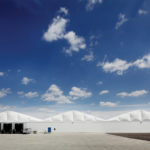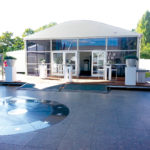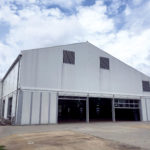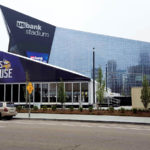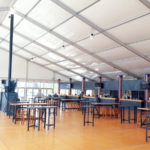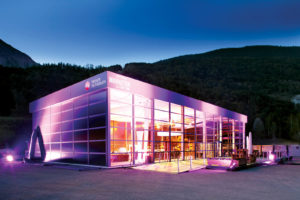
For Jeff McInnes, what better proof of the validity of clearspan structures being used for permanent buildings than having his recently installed aquatic center survive Hurricane Florence in North Charleston, S.C.
“We often install permanent structures that sometimes need to be in place for extended durations; anywhere from three to 30 years,” says McInnes, North American sales manager for HTS Clearspan Structure Systems, the U.S. branch of German clearspan manufacturer HTS Höcker GmbH. “The structures are engineered to meet permanent building codes and often are engineered to whatever MRI [Mean Recurrence Interval] the client requires.”
According to McInnes, the temporary structure codes are extrapolated from the permanent building codes, which require structures to meet safety and structural requirements for up to 50 years, the MRI for extreme conditions. Temporary buildings have an MRI average around two years. “We get a lot of installs to be placed in areas that have high winds or snow loads, and the roofs and structures are engineered to meet those loads,” says McInnes.
As more and more event rental companies learn of the clearspan advantages, clients are asking for more long-term installations. Unlike traditional tent structures, clearspans do not have a number of pole supports scattered throughout the interiors, but rather provide unimpeded spaces of various widths (as small as 10 feet wide and up to 200 feet wide) and almost unlimited lengths. “The reason these structures have taken hold,” says Thomas Pollard, vice president, Special Event Rentals, Edmonton, Alberta, Canada, “is for primarily two reasons: There is an absence of poles down the center, and the height of the sidewalls gives a more expansive feeling than other tent styles.”
Another advantage, especially for long-term usage, is the speed with which it can be installed. “A clearspan structure bridges the gap between building a [traditional] building and getting a structure operational quickly,” says Joe Langehaug, regional sales manager for Losberger U.S. LLC, the U.S. division of clearspan manufacturer Losberger De Boer Group, based in Germany. “It also eliminates the additional cost of having to erect and dismantle the clearspan after every use.”
Variety for variety’s sake
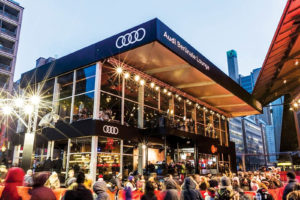
Long-term clearspans can take any form and are found in many settings that in the past would have required permanent construction methods. Permanent clearspans have been used for aquatic pool centers, tennis court structures, golf course cart storage, event and banquet halls, warehouses and vehicle garages, even fire station truck storage. “We have done quite a few warehouses with MRI 20 or more useable life spans for the auto industry, storage buildings to house parts and assemblies for the supply chains in automobile manufacturing,” says McInnes. “Also, our deployable code-compliant warehouses are vital to the oil and gas industry.”
Losberger handled a project for Chattanooga Tent & Event Solutions for a swimming pool enclosure: “A 25-meter by 30-meter Losberger structure was installed and no additional modifications were needed to the frame in order to meet IBC [International Building Code] and local codes,” says Langehaug. “Now the outdoor pool becomes a year-round swimming facility for a fraction of what new construction would cost.”
In a colder setting, a Losberger system feted attendees at the 2018 Super Bowl held in February in downtown Minneapolis. The NFL Minnesota Vikings franchise hosted visitors to the Super Bowl at its clearspan Vikings Longhouse structure, initially set up in front of the U.S. Bank Stadium in August 2017 at the beginning of the football season. The Longhouse stayed in place through the playoffs and the February season-culminating game.
Installation of the two-story, sloped-roof Vikings Longhouse was by Ultimate Events in Plymouth, Minn. “We do permanent clearspans for a lot of construction projects in the winter, especially as a place to stage equipment and materials,” says Kevin Moore, COO of Ultimate Events. “We have done a number of these types of structures for Target, which is in the process of remodeling their older stores. We set up the structures in a corner of the parking lot for six to nine weeks. When we do these, we make sure to be regularly on call in case there are any surprise snowfalls that might impinge on the roofs.” Moore says most clearspans are not snow rated, “but they can be heated and can provide the kind of clear space inside that can’t be provided by pole tents.” Inflatable roof panels help keep any snow from accumulating.
A surprising long-term application is found much farther south in Miami Beach, where a two-story structure is being installed to serve as a sales office for a luxury condo development still in construction. “HTS-USA just started installing a two-story system as an alternative to the typical ‘dressed-up trailer’ most often found,” says McInnes. “The first floor will be for sales offices and customer meeting rooms for closing on a unit; the second floor will be a full mock-up of the units being sold.”
Four-season flexibility
The great thing about clearspans, according to Biff Gentsch, national sales director for Anchor Industries Inc., Evansville, Ind., is that they are durable, sturdy and can hold up to 20 to 35 pounds per square foot of snow loads for temporary or semi-permanent applications. “And they can be thermally robust if fitted with an inflatable roof.” Gentsch cites a notable winter example in Chicago, where “there are two clearspan structures that have been up year-round for several years that have withstood Chicago winters because they are snow-loaded for 35 pounds per square foot. There are also tax advantages for these types of clearspan structures, because they are not classified as permanent buildings.”
The design of longer-term installations is determined by the engineer, who references both the IBC and local building codes. “The changes that may be required to meet engineering,” says Langehaug, “could be simply adding additional bracing at the leg-to-rafter connection, at the ridge, or installing an insert in the leg for added support for additional bracing. They may also require that the next profile size be used so the beams are larger.”
Other modifications, says McInnes, “might mean concrete footings or a concrete pad, depending on any increasing loads that might be on the base plates.”
What is driving the popularity of these structures is the innovations in manufacturing, in the precision and reliability of fabrication. Most manufacturers use CNC fabric cutters, so every top and every wall are identically cut and the angles are accurate. The same is true with the aluminum profiles; CNC lathes now do all the machining. For steel fittings, manufacturers are deploying robotic welders to ensure quality and consistency in every piece. With this precision, the structural framework of every setup—the box beams and extruded aluminum sections and channels—can be made to meet the codes and become a great incentive to clients, especially with regard to permitting issues.
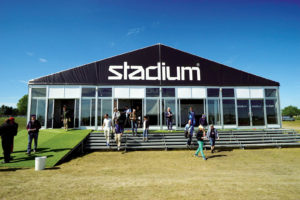
Another advance, according to Moore, is the use of hard walls that can be fabric or rigid panels. “The aesthetics are much better, not like the ‘shower curtain’ fabric walls of pole tents or frame tents. And they can be more secure,” says Moore.
Other key considerations are product support and access to replacement and expansion parts, says Nate Brancato, president of Liri Tent US, the U.S. clearspan supplier of China-based Liri Tent Technology Co. Ltd. “Rental companies are constantly having to invest and expand to meet market changes. If they pick the right line of clearspans (with flexibility and options), they can maximize their return on investment.
“What is the reliability of the supply chain and all the supporting materials (such as technical support) that allows owners of the clearspan product to present build concepts?” asks Brancato. “CNC machines, ISO certifications as well as the latest in fabric technology ensures the delivery of quality products for the rental company.”
Local jurisdictions apply
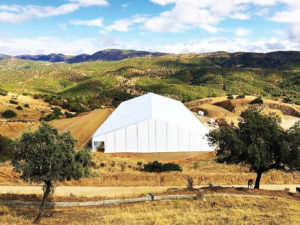
With all the jigsaw puzzle precision, is this a case where clearspans can avoid meeting building codes for permanent structures? Not necessarily, says Moore. Referring to the Vikings Longhouse installation, he says, “There was a bit of a go-around with the City of Minneapolis about the Longhouse not being temporary. Normally we have had a municipal fire department be the regulating authority regarding codes. The IBC defines a tent in a certain way, and it usually means the fire marshals review the specs and give approval. But not Minneapolis for the Longhouse. They said it was a permanent building and that it had to meet permanent building codes. In addition, the land in front of the Vikings stadium where the Longhouse is located is Minneapolis Park Board land, and the Park Board claimed it was the regulating authority.”
In the end, in spite of all the advanced technology available, it all comes down to people and building trust with top-notch service providers. Having a good product to begin with makes the sell that much easier. Carefully engineered clearspans are helping expand the uses of long-term installations, making them more feasible and, increasingly, more desirable.
Bruce N. Wright, AIA, senior instructor at Dunwoody College of Technology, is an architect and consultant to designers, architects and related professionals, and a frequent contributor to Specialty Fabrics Review, Fabric Architecture and Advanced Textiles Source.
Biff Gentsch, national sales manager for Anchor Industries Inc., Evansville, Ind., describes the growth of the clearspan market in North America as “dramatic.”
“Ten years ago there were only a handful of companies offering clearspan structures,” he says. “Anchor Industries had the foresight to see the potential of these structures. Early on, Anchor teamed up with a European manufacturer [Röder Zeltsysteme und Service AG] and began to change the U.S. market, pushing to educate the market to the advantages.”
As the style has taken hold and spread throughout North American rental companies, its success has further contributed
to its own market growth, according to Nate Brancato, president of Liri Tent US, the U.S. clearspan supplier of China-based Liri Tent Technology.
“Because the number of companies utilizing engineered structures is expanding, the opportunity to sub-rent and coordinate large events and installations is much broader than may have previously existed,” Brancato says. “All of this has resulted in a knowledgeable client base and future client base that is rapidly expanding beyond traditional tent styles, and we know this growth will continue.”
Jeff McInnes, North American sales manager for HTS Clearspan Structure Systems, the U.S. branch of German clearspan manufacturer HTS Höcker GmbH, says that multilevel structures will soon be a common sight at tented events.
“Currently there is real market demand for three-level configurations, as well as demand for structures with asymmetrical builds, with single, double and three-levels,” McInnes says. “And for creating ‘stadium seating’ on upper levels.”
Brancato predicts innovation around roof frame and glass design.
“These are two of the most popular design elements for innovation when building a structure,” he says. “We’re also seeing structures getting very large, some up to 200 feet wide. Conversely, more clients are using smaller engineered frame profiles that may have historically been addressed with small frame canopies.”
 TEXTILES.ORG
TEXTILES.ORG



